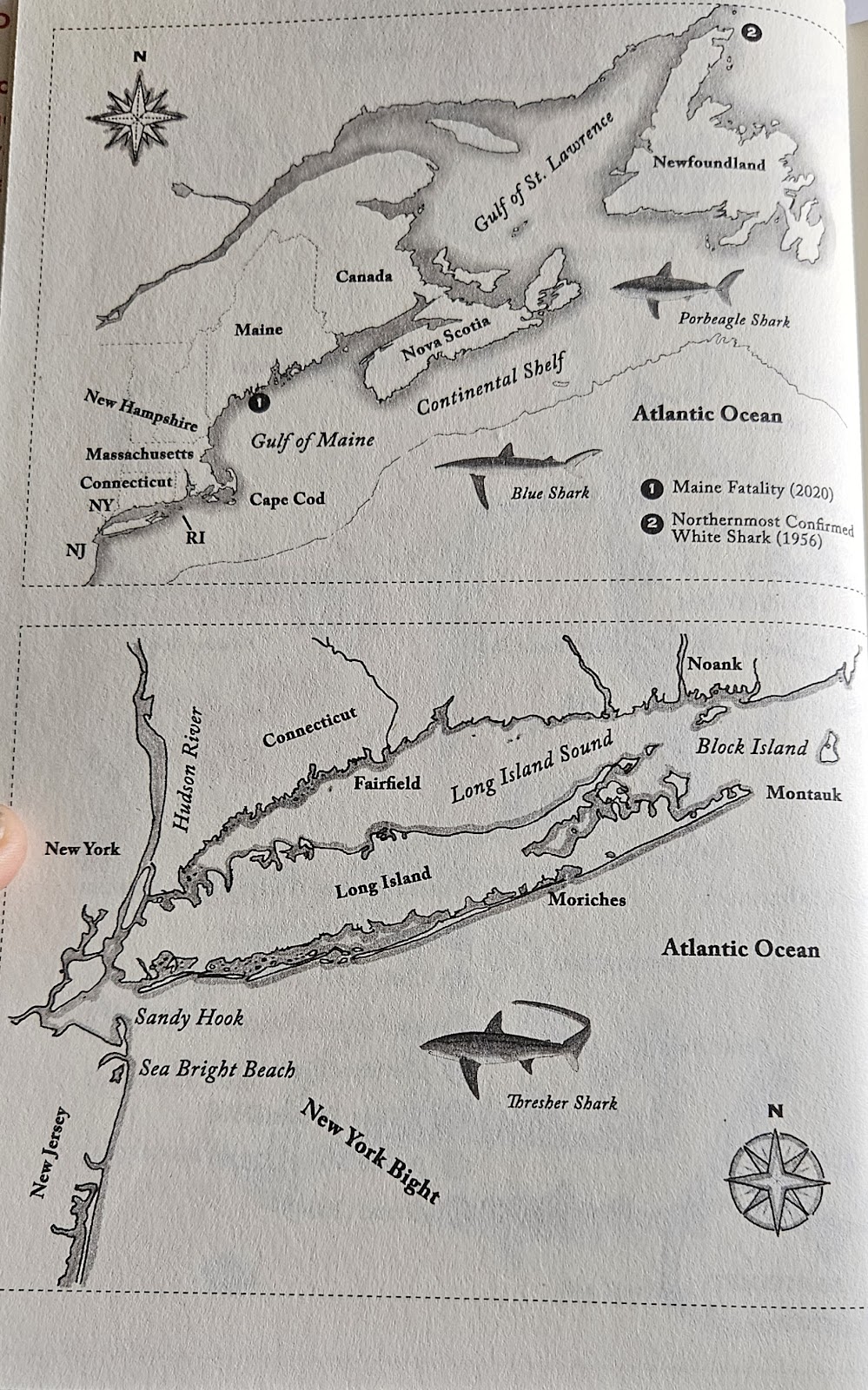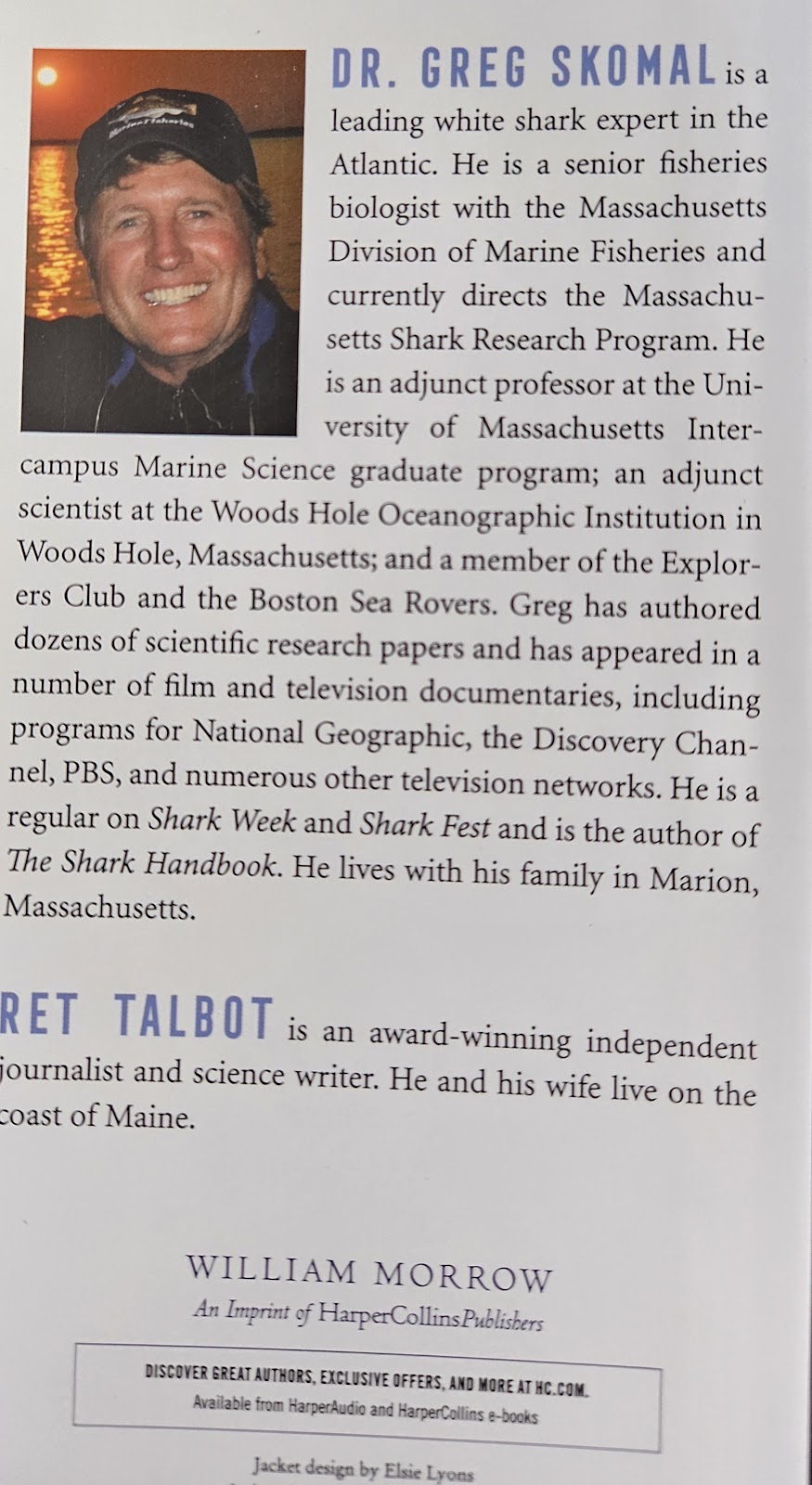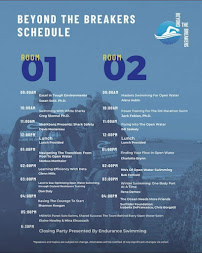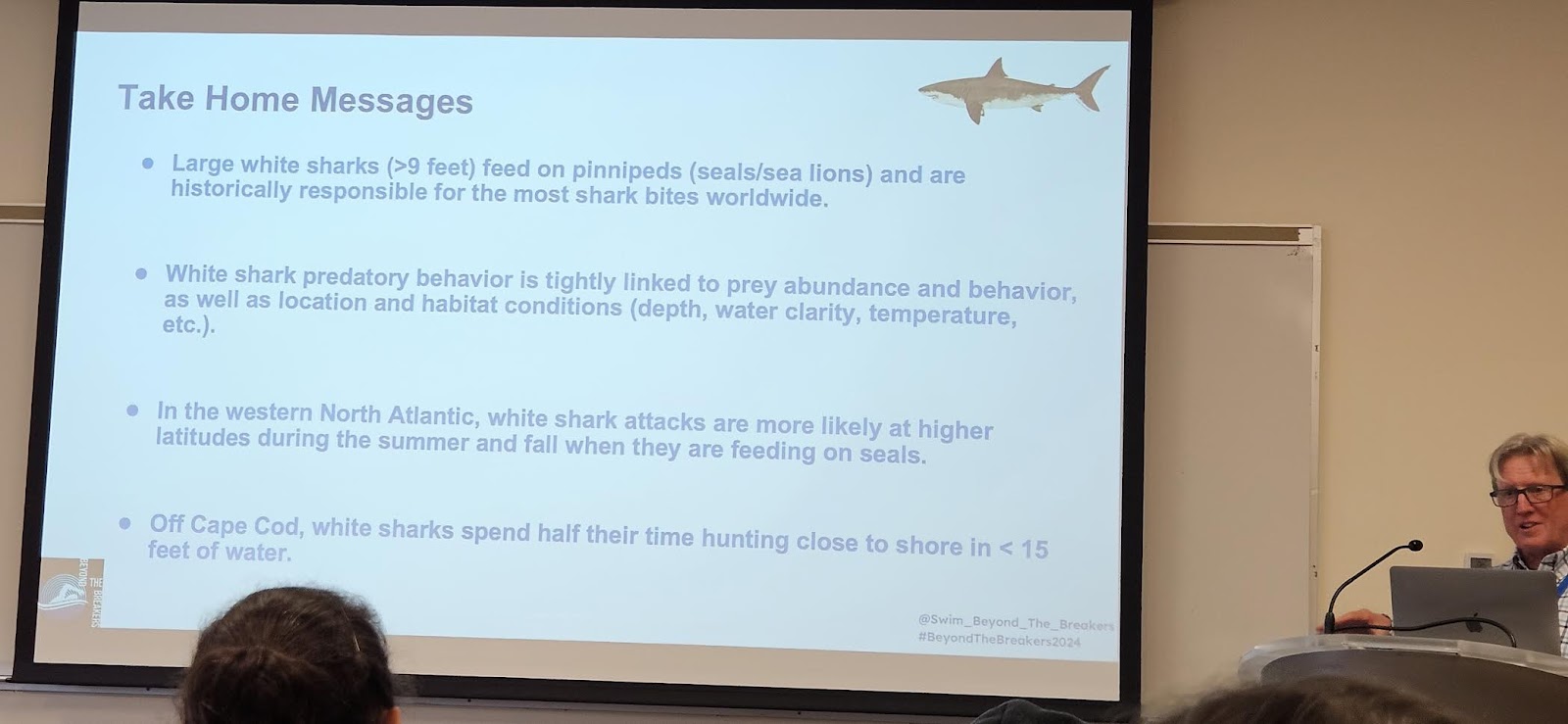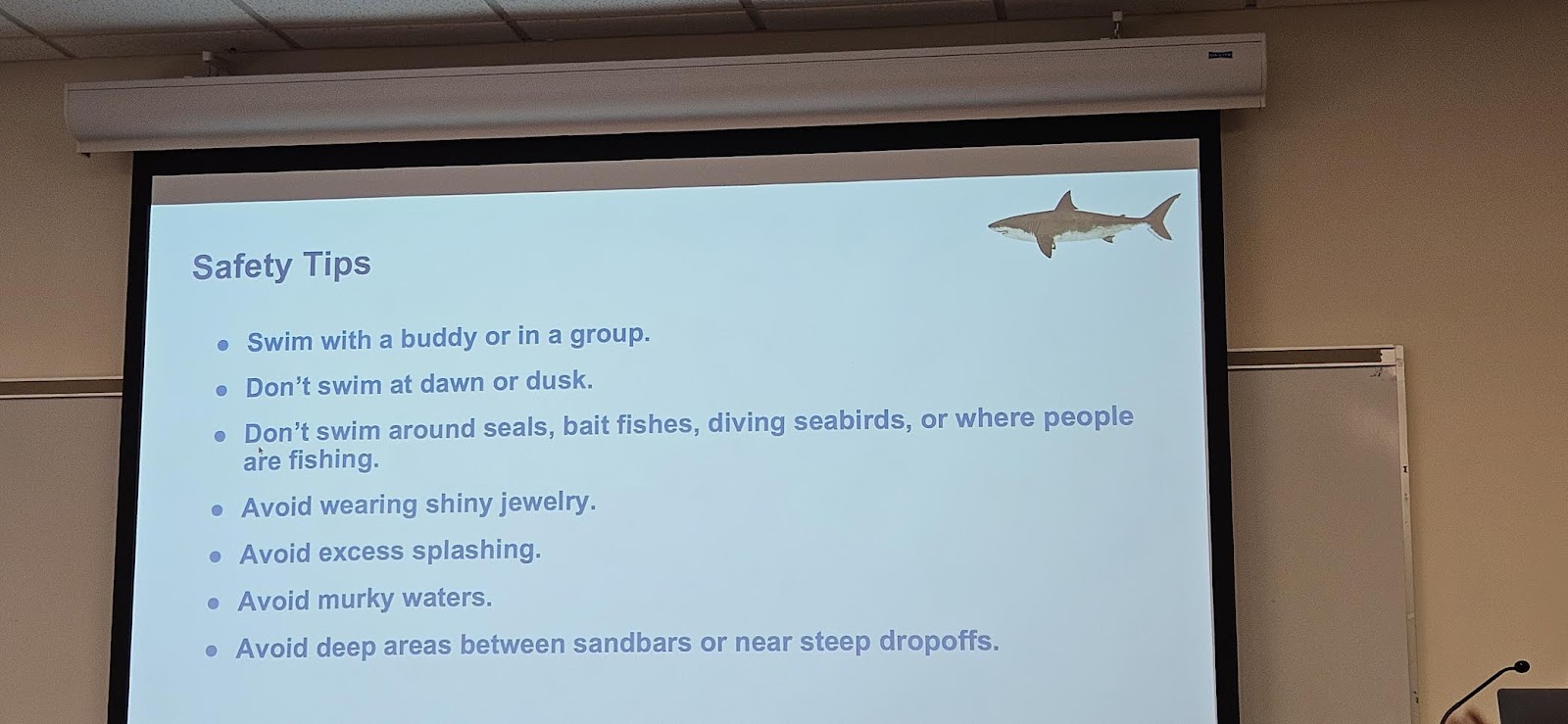Notes for HOWS
Beyond the Breakers Conference Saturday 9 November 2024 Bentley College in Waltham, MA.
Sharks! Yes, Sharks. I know many of you are learning how to be comfortable in the cold ocean of Maine, but first we must address our neighbors, the Great White Sharks. When I first came to Harpswell it was the summer of 1972.
1972: The #1 movie in America was, drumroll, JAWS! I grew up in a huge family and whenever we went swimming that summer, always in the ocean, one of us would start singing the refrain from the movie ~ the music that let you know, a Great White was coming for you! We knew there were sharks in the water, because we used to catch and eat dogfish/sand sharks from kayaks and canoes. That was until we caught a pregnant shark and felt horrible when the babies revealed themselves.
1972: The year that the Marine Mammal Protection Law was passed. Seals and other Marine Mammals were being slaughtered for sport, food and spite. It was the era when Harpswell fisherman would shoot seals that they felt were competing for their fish, bait, or lobsters. Instead of seals washing ashore with jagged tooth marks, then they were found riddled with bullet holes.
1997: The year that the Great White Sharks became protected. The author of Jaws, Peter Benchley spent much of his life after the books were turned into film, trying to save White Sharks and ultimately all sharks with a conservation effort. He tried to unteach the fear and educate folks about the sharks necessary and vital position in the environment.
The White Sharks arrive in the North Atlantic in trickle in April, slowly gather over the summer, and in are peak numbers August through October. Sharkbanz was a Gold Star sponsor of the event and I attended the co-founder's session. My goal with this section is to reassure you that although we share Casco Bay with the White Sharks, but there are many ways to deter and mitigate our interacting with them.

I attended Dr. Greg Skomal's session entitled: "Swimming with White Sharks." To say he is an expert on all things Great White would be an understatement. Dr. Skomal is a diver, scientist, researcher, innovator, author, and photographer. He describes his work on the East Coast as trying to "curb conflict" between humans and sharks. As the seal populations have ballooned back since the Marine Mammal Protection Act was enforced, the population of sharks has grown proportionally. One of his many titles includes working for the Mass. Div. of Marine Fisheries, in the Fisheries Biology, Recreational Fishing, Survey and Assessment section as the Program Manager covering Large Pelagics and Diadromous Fisheries.
As a former English teacher and Literary Agent, I'm all about definitions! According to NOAA (https://oceanservice.noaa.gov/facts/pelagic.html), this is the definition of a Pelagic fish:
"Pelagic fish can be categorized as coastal and oceanic fish, based on the depth of the water they inhabit. Coastal pelagic fish inhabit sunlit waters up to about 655 feet deep, typically above the continental shelf. Examples of species include forage fish such as anchovies, sardines, shad, and menhaden and the predatory fish that feed on them. Oceanic pelagic fish typically inhabit waters below the continental shelf. Examples include larger pelagic fish such as swordfish, tuna, mackerel, and even sharks.
There is no distinct boundary from coastal to ocean waters so some oceanic fish become partial residents of coastal waters, often during different stages of their lifecycle. However, true oceanic species spend their entire life in the open ocean.
Pelagic fish get their name from the area that they inhabit called the pelagic zone. The pelagic zone is the largest habitat on earth with a volume of 330 million cubic miles. Different species of pelagic fish are found throughout this zone. Numbers and distributions vary regionally and vertically, depending on availability of light, nutrients, dissolved oxygen, temperature, salinity, and pressure."
Diadromous fish is general category describing fish that spend portions of their life cycles partially in salt water and partially in fresh water. Here in Harpswell that would include: Pogies/Herring/ Menhadden, Sardines, Shad, Sturgeon, Eels, Striped Bass, and Salmon. These fish either lay eggs in freshwater and then live in saltwater or the other way around. The summer of 2020, there was an abundance of these fish in the waters around Harpswell, which are prime food for juvenile White Sharks.
Dr. Skolam studies the prey of the young and mature White Sharks. The prey of the young sharks is almost exclusively fish, while the prey for the adults is primarily marine mammals, as you see in the charts below. The picture of the "new born" Great White is on the left and a mature Great White on the right. White Sharks become "mature" when they are 8-10feet long. Notice how their diet changes as they grow.



Now, why the heck am I sharing all of this with you???? Because as Dr. Skolam continued his session addressing Open Water Swimmers (who swim in White, Bull, and Tiger shark infested waters all around the world) he said that his 40 years of studying sharks had revealed a great deal and contributed to the "curbing of conflict on Cape Cod" however he'd been "totally startled" by the strike and death of the swimmer in Harpswell, ME. I raised my hand at that point, said I was a swimmer from Harpswell, and had heard reports of the victim being in a grey wetsuit, with juvenile seals in the cove, and there being excessive bait barrel wash in the water that day. He said that was reported to him as well. The South East end of Mackerel Cove has deep water, with a drop off, and is very near ledges populated by seals throughout the tide cycles. The perfect storm for our Harpswell victim, as she was swimming in bait barrel wash, a grey wetsuit, and in a cove with young active seals ~ not safe practices, as we would learn over the course of the hour. Here is a nautical chart of the exact area:

was interviewed in this DownEast article in 2020 about the fatal attack:
https://downeast.com/land-wildlife/shark-attacks-in-maine-were-unthinkable-until-last-summer/
In the Down East article from 2020, you'll notice that he says they had tagged "230 animals" (White Sharks). At the session last Saturday in Waltham, Dr. Skolman said they now have "380 individuals tagged" which he thinks accounts for 10-20% of the adult population the North Atlantic. So we have more sonic insight, but we also need to realize that we are always swimming with sharks.
Per the definition of Perlagic Fish, the White Sharks stay in deep water most of the time, 100-600 meters. However, when hunting they can come into 30-40 meters to scan and troll the shores-ledges for marine mammals. In his studies of the Cape, many sharks hunt for the high value blubber of the North Atlantic Seal in less than 15 feet of water.
The clearer the water, the less likely a swimmer will be "accidentally" attacked. What does clarity have to do with it? Teenage sharks, transitioning from a mostly fish diet to a mostly mammal diet, will often bump their prey to make sure it's a mammal. They may "bump and abort" if it feels like the wrong prey. However, they can also take a taste and leave. When the water is murky they are less like to see waste the energy to strike. Dr. Skolam has added accoustic monitors, like those on the Cape, to track Sharks in Casco Bay. They are gather a great deal of information about individuals as well as population behavior. There are apps like Sharktivity to download for recent reports of "tagged" individual sharks and unconfirmed human sightings in Casco Bay/Harpswell.
That fateful day in July 2020, seals had been swimming in Mackerel Cove all day. From great depths, a dark bathing suit or wetsuit may have a swimmer being scanned as a seal by a White Shark. In the article it stated the victim and her daughter where "diving and splashing" for hours that fateful afternoon, which are seal-like behaviors, and remarking on the "clarity of the water" (which would normally be a deterrent- as they could usually discern human from seal).
When I asked Dr. Skolman about the practice of surfers painting their wetsuits with stripes across their suits to break up their profiles from below, he said, "that is a good deterrent." (In a later session, I asked the co-founder of Sharkbanz, Davis Mersereau, the same question, and he replied that he's heard of surfers and swimmers painting their suits and agreed it was a decent deterrent to add to one's safety strategy). I haven't not worn a wetsuit in nearly 8 years. When I do swim in Open Water, you'll find me in suits with crazy patterns, never solid colors, to look like the water's surface or a light bellied fish, not a seal.
Finally, the Down East article also said that the strike happened in the afternoon. If you look at Davis Mersereau's chart (below), you'll see some of what the best safety strategies for Open Water Swimmers sharing the oceans with sharks:
Take home messages from Dr. Skolman:
***********************************
A big part of why I'm writing all this today is to hopefully have you join me year round, not only as a dipper and plunger, but ideally to encourage you to venture into the world of Open Water Swimming and in the winter, Ice Swimming. At the Beyond the Breakers, one of the Speakers, Bob Fernald, offered to come give his presentation to our group in the new year. He was the director of the Nubble Challenge, is a Triple Crown swimmer and, most importantly, a wonderfully positive coach and person.
Finally, I hope to wrangle, either in-person or on Zoom, Rena Marie Demeo, (see her credentials in her slide) to also address HOWS. She is a really inspirational person, who was also not a "pool swimmer" in her youth and now guides many of us to do more than we think we can ~ while simultaneously having fun and being safe!
See you Sunday Funday at Mitchel Field Beach!








